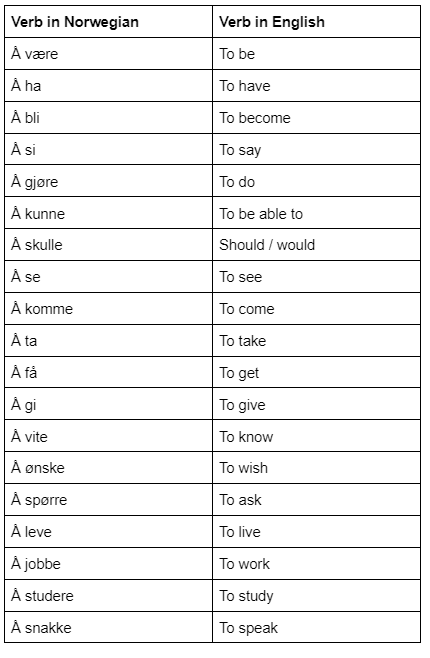
Is Norwegian the easiest language to learn?
Norwegian may seem daunting to learn at first. All these strange words and clusters of consonants may appear impossible to grasp. But if you take a deep breath and really look a bit deeper, you’ll find that Norwegian is one of the easiest languages to learn, especially if you’re an English speaker.

Key takeaways
- Norwegian is a Germanic language, like English
- Syntax and cognates will be recognizable
- Norwegian has a fairly simple grammar structure
- Learning Norwegian will serve as a gateway to other Scandinavian languages
- You’ll be better prepared for travel, work, and life in Norway by speaking the language
- It is the easiest of the Nordic languages to learn
Why Norwegian is the easiest language to learn?
Many will claim that Norwegian is one of the easiest languages to learn. This is of course a relative statement, but if you speak English, it is definitely very easy to come to grasp with.
English and Norwegian may sound completely different at first glance, but their similarities make themselves known once you start learning the language.
Syntax
Firstly, let’s take a look at the syntax. What exactly is syntax, you ask? Well syntax is the set of rules that determine what order words are placed in sentences. You may know all the vocabulary, but you’ll never speak a language fluently if you don’t know which order they should be in.
This is one of the more challenging aspects of language learning, as if the syntax is different from what you are used to, it will take a longer time to create a greater sense of flow. Norwegian and English share remarkably similar syntax, thereby making it easy to learn. Both are what we call S-V-O languages, meaning the basic structure of sentences should have the subject first (S), then the verb (V), followed by the object (O).
Some differences in syntax will present themselves as you delve deeper into the learning process, but the similarities make Norwegian a breeze for English speakers.
Grammar
The grammar rules are also exceedingly easy to grasp. There are four main verb groups, and knowing which one a verb belongs to will help you conjugate the verb for whoever the verb is referring to, and whichever tense you may want to place the verb in.
For example, if adding the letter R after a verb in the infinitive places the verb in the present tense. This will then be the same verb no matter who or what is doing the action. Take a look:
- Infinitive: Å ha (to have)
- Jeg har (I have)
- Du har (you have)
- Han/Hun har (he/she has)
- Vi har (we have)
- Dere har (you all have)
- De har (they have)
The system of one verb form applying to all pronouns applies to every single verb in the Norwegian dictionary. So say goodbye to remembering 17 different verb conjugations for each verb, and say hello to the ease and simplicity of Norwegian.
Pronunciation and intonation
Pronunciation and intonation are a bit more complicated to get a firm understanding of however. For the most part, what you see is what you get with Norwegian, but there will be some head scratches along the way.
Sometimes the letter T or D at the end of a word will be silent, but sometimes they will not. Sometimes a letter will be pronounced one way, and in other words it will be pronounced another way. What makes this difficult is that there is not always a rule to determine how certain words should be pronounced.
This is why we in Norwegian Community focus on conversation classes. This is because, hearing others speak, and speaking yourself will help engrain the proper pronunciation and intonation in your brain and make it easier to recall. This will not happen if you only focus on reading as your main learning method.
That being said, Norwegian is still much easier to pronounce than the other Scandinavian languages. Danish for example has a notoriously difficult pronunciation. And Swedish has a bunch of dots and apostrophes that may seem foreign to English speakers.
With Norwegian, you’ll have three new letters to learn, Æ, Ø & Å, but their sounds are all present in the English language. Take a look:
- Æ – The A sound in cat or bat
- Ø – The U sound in hurt or burn
- Å – The O sound in score or for
Vocabulary and cognates
Norwegian is a Germanic language along with many other languages. This means there are bound to be plenty of words you’ll recognize if you speak another Germanic language. The cognates, or words that have a similar origin, will be similar for a swath of the vocabulary. Studies show that learning a language with familiar cognates will help you out in the process.
Take a look at this sentence from the about section from one of Norway’s largest newspapers, Aftenposten.
Aftenposten gir deg ny innsikt og et raskt nyhetsoverblikk. Vi hjelper deg med å forstå hvorfor ting skjer, og hvordan verden henger sammen.
Now let’s find the cognates here.
- “Aftenposten” (the name of a Norwegian newspaper) contains the English word “post”
- “ny” (meaning “new” in Norwegian) is similar to the English word “new”
- “innsikt” (meaning “insight” in Norwegian) is similar to the English word “insight”
- “raskt” (meaning “quickly” in Norwegian) is similar to the English word “fast”
- “nyhetsoverblikk” (meaning “news overview” in Norwegian) is similar to the English words “news” and “overview”
- “hjelper” (meaning “helps” in Norwegian) is similar to the English word “helps”
- “ting” (meaning “things” in Norwegian) is similar to the English word “thing”
- “verden” (meaning “world” in Norwegian) is similar to the English word “world”
- “henger” (meaning “are connected” in Norwegian) contains the English word “hang”
So based on this, perhaps you’ll be able to suss out the meaning if you’ve never heard a Norwegian word before in your life. Give it a try and check the translation under to see how close you got.
Aftenposten gives you new insight and a quick news overview. We help you understand why things happen and how the world is connected.
Did you get close? Either way, it’s plain to see how common roots of many Norwegian words will help you learn the language easier.
Is Norwegian easier to learn for English speakers?
We’ve established that Norwegian is easier to learn for English speakers. You have similar syntax, there are plenty of common cognates, and the grammar makes it a breeze to learn. But what are some of the specific tips for an English speaker hoping to learn Norwegian?
Think about the cognates
As mentioned, both Norwegian and English are Germanic languages. This means that they both have their origins in the same root language, otherwise known as cognates. This means that if you see a Norwegian word that seems similar to English, chances are they mean the same thing.
Additionally, if a word doesn’t seem to share an obvious similarity with English, thinking of other words that sounds similar could lead you in the right direction. Or if that fails, old English might help you out. Take for example these words.
- Skrive (to write) – similar to scribe in old English
- Hund (dog) – similar to hound in old English
- Språk (language) – similar to speak
So if you’re able to see a similarity between Norwegian and English, just go for it. Chances are you’ll be right.
Plenty of material
You’ve probably heard that all Norwegians speak perfect English. While perfect might be a strong adjective to use, we definitely speak a high level of English in Norway. This also means that we like to consume plenty of English language content.
Be it Netflix, movies, podcasts, or everything in between, you’ll find Norwegian translations of it all. So next time you want to relax on the couch and watch your favorite show, why not set the subtitles toNorwegian?
This also works the other way around. Any piece of entertainment content from Norway will likely have an English translation, making it a breeze to translate and ingratiate yourself in the language.
Join our classes
Lastly, we of course have to recommend our courses and conversation classes. We use English as a common 2nd language in all our classes. So you’ll always be able to switch to English if you get stuck in any of our conversations.
The higher you go, and the stronger your Norwegian becomes, the less English you’ll need. This is also reflected in our classes. But for the beginner or intermediate, it’s nice knowing that the people you’ll be conversing with all speak English, and are in the same situation as you are.
The teachers also switch to English to explain difficult vocabulary or grammatical rules, to ensure that it all makes sense to you.

Learn fluent Norwegian in 4 months. Start today.
Did you know that you don’t need all the grammar to speak fluent Norwegian? In our classes we focus just on the necessary vocabulary. So you can learn 3 times faster.
Advantages of learning Norwegian for an English speaker
So we now know that being an English speaker will give you an advantage in learning Norwegian. But why should you even bother learning Norwegian in the first place? Well, for several reasons. It’s a gateway to other Scandinavian languages, it’ll help you with cultural immersion, it will open up opportunities for work and education in Norway and it will give you certain benefits as a traveler.
Norwegian language as a gateway to other Scandinavian languages
Norway may not be the biggest, the most popular or the most highly populated country in Scandinavia, but the language is the perfect middle point between all the Scandinavian languages. This means that by learning Norwegian, you’re essentially learning Danish and Swedish too.
Norwegian was under Danish rule for over 400 years, until independence in 1814, and then in a union with Sweden up until 1905. This means that our language has been influenced by both countries to a high degree.
If you look at Norwegian and Danish writing, they’re almost exactly the same. You can pick up most Danish books and understand them without problem if you speak Norwegian. Understanding their pronunciation might be a tad harder though.
That’s where our advantage with Swedish comes into play. Our writing may be different, but the way we pronounce words, and our vocabulary are remarkably similar. Meaning you’ll have no problem communicating with a Swede when you can speak Norwegian.
Learning Danish or Swedish first will not give you the same advantage though. So you can’t learn Danish hoping to understand your Swedish friends, or the other way around. Only Norwegian offers this three in one deal.
Cultural immersion and experience
Norwegians all speak English. Why should I bother learning Norwegian? That’s a question many foreigners ask themselves when moving to Norway. But ask them what they think about Norwegians after a little while, and they’ll tell you we can be a bit closed off and antisocial. That’s where speaking Norwegian comes in handy.
It’s true that English is spoken by most Norwegians, but that does not mean they’re all comfortable doing so. Yes we will help you with directions, and find us a couple of beers deep on a Friday night and we’ll talk your ear off in English.
However, in order to get to a deeper conversation and connection, and to make real relationships, Norwegians need to be comfortable. And we are most comfortable when speaking our native tongue.
So in order for you to make real connections with the people in Norway, you’ll also need to speak Norwegian. This is an essential skill for anyone hoping to be social with Norwegians.
Education and employment opportunities in Norway
The above point also applies to anyone hoping to build a career in Norway. You’ll need to be able to speak the language for employers to find you attractive. And certain university programs are also only offered in Norwegian.
Yes, it’s true that you may be able to find work if you only speak English. But these jobs are either highly specialized, or low on the societal totempole. For the rest of you, Norwegian will show your future employer that you take living in Norway seriously. That you plan to stay long term, that you are a hard worker, and that you make an effort.
All these traits are some of the major qualifications posted on any job listing in Norway, and being able to speak the language will give you solid proof that you possess all of them.
You may also have heard that education is free in Norway. Though not true for every single school in the country, it is certainly the case for most of them. In fact, the best universities in Norway are free. So if you want to take advantage of this opportunity, why not come to Norway?
Oh wait, perhaps your field isn’t offered in English? How will you be able to follow the lessons and material in Norwegian? Why, by speaking Norwegian of course! You’ll open up a whole new branch of the educational tree, and be able to study anything you heart desires.
Travel and tourism advantages
Lastly, there is a lot of history in Norway. Anywhere you’ll go the country’s history is on display. And in order for you to get all of it, you’ll need some Norwegian. Since the language has plenty of roots in old Norse, being able to see some of the similarities when traveling will make for a more authentic experience.
Additionally it will give you a chance to get to know the locals better, as speaking Norwegian is far more comfortable for Norwegians than speaking English. Sure, they’ll help you out with directions or when ordering at a restaurant, but you won’t find many fun or interesting conversations in only English. That’s why knowing some Norwegian is beneficial even to tourists who only plan on visiting the country.
What makes Norwegian unique and easier to learn?

There are several areas you’ll want to focus on in order to make Norwegian easier to learn. Deciding to learn a new language can be daunting, so breaking it up into easier bite sized chunks makes the whole process seem more doable. We’ve got a handy list to help you make this unique language easier to learn. They are knowing the genders of nouns, the unique letters, how its spelling relates to pronunciation, intonation, regular verbs, some commonly used verbs, and lastly, some tips for mastering verb conjugation.
Number of genders in the Norwegian language
Though Norway ranks as one of the highest in the world in terms of equality between the genders, we still have gendered nouns. In fact we have three of them! Knowing the difference between them is essential for anyone hoping to speak the language fluently.
What makes it difficult to master, though, is that there are no obvious ways to tell whether a noun is masculine, feminine, or neutral. It will take time and practice to learn which article comes in front of which noun, but eventually it will become second nature.
Masculine nouns
The indefinite article for masculine nouns in Norwegian is “en”. So, you would say:
- En mann (a man)
- En gutt (a boy)
- En student (a student)
In the definite form of the noun, you need only add “en” to the end of the noun. So, you get:
- Mannen (the man)
- Gutten (the boy)
- Studenten (the student)
Feminine nouns
With the feminine nouns, the indefinite article in front nouns is “ei”. Here are three examples:
- Ei dame (a woman)
- Ei jente (a girl)
- Ei bok (a book)
For the definite form, you need to add “a” at the end of the noun. In this case we get:
- Dama (the woman)
- Jenta (the girl)
- Boka (the book)
A little trick here is that the indefinite article and the ending for feminine words can be swapped with the masculine article and endings. In fact, plenty of Norwegians only use the masculine forms for both masculine and feminine nouns. So you only need to learn one if you really want to. We then get:
- Damen (the woman)
- Jenten (the girl)
- Bokeh (the book).
Neutral nouns
Neutral nouns have the indefinite article “et” in front. Giving us:
- Et hus (a house)
- Et land (a country)
- Et bord (a table)
In the definite form, we at “et” at the end of the noun. The same nouns in the definite form then become:
- Huset (the house)
- Landet (the country)
- Bordet (the table)
Unique Norwegian vowels (Æ Ø Å)
Learning Norwegian will introduce you to three new letters. They come at the end of the alphabet. These are Æ, Ø og Å. They are used pretty frequently, so you’ll need to know them in order to speak and write with fluency. Though the sound they produce can be found in many other languages, Norwegian is the only language that uses these specific letters, making it all the more unique.
The first of these three letters, Æ, is pronounced like the “a” sound in the word “cat” spoken in an American accent. It can also be heard in the “a” sound in the word “bat“, or the “a” in the word “bath”. Also when spoken with American English.
The second letter, Ø, can be pronounced much the same as the “o” sound in the “word”, the “i” in “bird”, or the “u” in “fur”.
Lastly, the Å is pronounced the same as the “au” in “caught”, spoken in British English, the “a” in “walk”, also in British, or the “ou” in the British pronunciation of “bought”.
Norwegian spelling and its relation to pronunciation
Norwegian spelling and how it’s pronounced is pretty straightforward. For the most part, what you see is what you get. But there are some strange rules along the way. Here are some things learners need to be aware of.
Silent letters
Norwegian has plenty of silent letters. Most of the question words, for example, (who, what, where, when, why) start with the letter H in Norwegian (hvem, hva, hvor, når, hvorfor). But you don’t pronounce the H in any of them.
The same applies to the endings of neural nouns in the definite form. As we mentioned above, you add “et” to the end of neutral nouns in their definite form. We used the examples; huset (the house), landet (the country), and bordet (the table). But with all of these you wouldn’t pronounce the “t” at the end of the word.
There are plenty more silent letters in Norwegian, and though you’ll be able to make yourself understood if you still pronounce them, you’ll never speak fluently until you don’t. That’s why practicing conversational Norwegian with others is so important in the learning process, and why we focus on this particular aspect of language learning.
Consonant clusters
Norwegian may seem daunting when looking at long words with many consonants after each other. Just take a look here:
- Skje (spoon)
- Stjerne (star)
- Sprett (bounce)
- Gnist (spark)
Knowing how these groupings of consonants are pronounced is something you’ll need to master. The most common one from the list above is the “skj” or “kj” combination. It’s pronounced much like the “ch” in English, but with a softer sound.
Tones and intonation in the Norwegian language
When it comes to tone and intonation, you’re in luck! Or not, depending on how you view it. Because of the country’s history under Danish rule, a ton of different dialects have emerged in the country. This means there is no official correct pronunciation of any word in Norwegian.
Hurray! This means that if you speak with your native accent, you technically don’t have a wrong accent, just different. Easy right? But on the other hand, this also means that there are a variety of different ways Norwegians will pronounce the same words.
And though some might be easy to understand, some might be difficult. Even to Norwegians, some of the dialects can be tricky, so just be aware of that.
Simple and regular Norwegian verbs
As stated above, we have 4 verb groups for regular verbs in Norwegian. Most verbs will fit into one of these groups, so any Norwegian learner will have to familiarize themselves with these four groups.
Before we take a look at the groups, we just have to make a few limitations. There are plenty of verb tenses, and we can’t cover them all here. So we’ll instead cover the four most common verb tenses. These being; infinitive, present tense, past tense, and the present perfect tense. You’ll also be happy to know that the present tense of all verbs always follows the same rule, simply add the letter “r” after the verb.So all we really need to know is the endings verbs get in the past and present perfect tenses. With that out of the way, let’s take a look at the verb tenses.
Group 1 (-et,-et)

Group 2 (-te, -t)

Group 3 (-de, -d)

Group 4 (-dde, -dd)

So there you have it. The four verb groups in Norwegian. Two things complicate this however. There is no way to tell which group a verb belongs to, but eventually, with enough practice, it will become second nature. And There are also plenty of irregular verbs that don’t fall under the rules of these four groups, so again, you’ll have to practice practice practice.
Common Norwegian verbs for everyday use
Alright, so we have our 4 verb groups, but what verbs should we learn first? Here is a list of 20 very commonly used verbs in Norwegian that any Norwegian learner will need to know as soon as possible.

Tips for mastering Norwegian verb conjugation
While we could tell you that you should study and write down all the verbs you encounter in your language learning journey, we have found one thing to be especially beneficial. That is to practice your Norwegian in conversations with others.
If you take a look at the verbs in the section above, you’ll find that most of them are irregular. Meaning they don’t fit into one of the four verb groups. So focusing on learning the rules might not actually be as beneficial as you’d hope.
Conversations with others is the only true way to see how naturally and easily you can recall language. Sure you can take a look at your notes, and find out which group a verb belongs to when you’re writing and reading. But you won’t have the same luxury when you’re actually talking to someone.
Therefore, we believe the best way to learn and become fluent is through conversations. That is why we offer the conversation classes we do. We have a proven track record with getting our students to fluency quickly mainly through conversions.
Learning what feels right in the use of another language is a sign of fluency. Thinking about verb groups and grammatical structures and rules is not something one does when they are fluent in a language, so we try to leave this by the wayside. This is not to say that we completely ignore grammatical structures and rules, but we don’t make it a focus in a way that many other language schools do.
Learn fluent Norwegian from your level
Check your level now, and find the right course for you
Our classes has native Norwegians who knows how it feels to learn a language, and will do everything to help you.
Is Norwegian easier to learn for a Spanish speaker?
Learning a second language and how easy it is to learn will depend heavily on the learner, but there are some factors that play a part. Spanish speakers will have some advantages and some disadvantages.
Let’s take a look at the similarities first. Both Norwegian and Spanish are Indo-European languages. What does that mean, you ask? Well, simply put they share some grammatical and vocabulary similarities. But this only goes so far.
When it comes to pronunciation, however, Spanish speakers have an advantage. Many of the same rules apply, and both have a rolling ‘R’ sound that is prevalent.
What about the differences? These are more plentiful than the similarities. Firstly, Norwegian is a Germanic language, while Spanish is a Romance language. So, the grammar and sentence structure will be different.
In Spanish, you have two genders to worry about, whereas Norwegian has three, and no obvious way of knowing which noun falls under which gender. But when it comes to verb conjugation, Norwegian has a much simpler system than Spanish does, so Spanish speakers shouldn’t worry too much about learning the same number of conjugation rules as they have in their own language.
Is Norwegian easier to learn for a French speaker?
Much of what was said above about Norwegian compared to Spanish also applies to French. They are both Indo-European languages, so they share some similarities. But Norwegian is a Germanic language, while French is a Romance language. Additionally, Norwegian has three genders while French only has two.
The biggest difference here comes with the pronunciation. Norwegian, like French, has a bunch of silent letters. But French much more so than Norwegian. As such, learning to pronounce the Norwegian words for a French speaker might prove a tad more difficult than for speakers of the other Romance languages.
Tired of scrolling through the internet for Norwegian grammar?
Start an organised Norwegian course now.
In order to learn fluent Norwegian, we need to repeat it and speak it several times before our brain learns it.
Learn that in our courses!
Is Norwegian easier to learn for a Portuguese speaker?
What about Portuguese speakers? IS Norwegian easier to learn for them? Well, again much of the same that was said about Spanish and French speakers is relevant here too.
They are Indo-European languages, so some advantages will present themselves because of this. But given that they diverge after that, with Norwegian being Germanic and Portuguese being a Romance language, means you’ll have a different sentence structure and grammar rules.
Verb conjugation also varies, with Portuguese having a more complex system than Norwegian does. So, Portuguese speakers will not have to learn a similarly complex system that they are familiar with from their own mother tongue. It could then be an advantage to learn a second language that doesn’t share the same level of complexity.
What are the easiest Nordic languages to learn?
Norwegian is only one of the Nordic languages. And with Norway being a relatively small country, you may be wondering why you should learn Norwegian instead of, say, Swedish or Danish? Well, Norwegian is the easiest of the Nordic and Scandinavian languages to learn. And it also works as a great middle point between these other languages.
The Nordic languages consist of Danish, Swedish, Finish, Icelandic and of course Norwegian. Finnish and Icelandic are so different from the other three languages, that speakers of them couldn’t hope to converse with Norwegians, Danes or Swedes in the same way that they can converse with each other.
Let’s first take a look at Icelandic. Like Norwegian, Icelandic is a Germanic language. They both have their roots in old Norse, however Icelandic hasn’t changed much, whereas Norwegian has evolved. So while the two languages originate from the same tree, the branches are very far apart at this point in time. Finnish, on the other hand, is a Uralic language, so the grammatical structures, vocabulary and general rules within the language are not similar to Norwegian at all.
We’ve already mentioned how learning Norwegian is a three in one deal, giving you Swedish and Danish at the same time. But even removed from that excellent selling point, Norwegian itself is easier to learn. Unlike Danish, the pronunciation more closely resembles the spelling of the words. And unlike Swedish, the spelling and new letters aren’t as abundant.
This means that learning Norwegian will put you on a faster track towards fluency than the two other languages. And unlike Norwegian, choosing to learn Danish or Swedish will not let you converse with other Swedes or Danes, respectively.
Reach fluent Norwegian in only 4 months
Find out your level and how to get started now
Did you know that you don’t need all the Norwegian grammar to speak Norwegian? Just a small part of it. In our classes we use just the necessary grammar. Find out what level you are, and what classes you can take to speak fluently.
Frequently asked questions about Norwegian being an easy language to learn
Why Norwegian is the easiest language to learn?
Norwegian is the easiest language to learn for several reasons. The grammar is fairly simple and verb conjugation is not as complex as with many other languages. Additionally it is a Germanic language, like English, so you will find similar vocabulary and grammatical structures as with similar languages.
Is Norwegian easier to learn for English speakers?
Yes, Norwegian is easier to learn for English speakers. They are both Germanic languages, so the grammar and sentence structure follows a similar pattern. You will also find much of the vocabulary to be similar and intuitive to understand.
Learn fluent Norwegian in 4 months. Start today.
Did you know that you don’t need all the grammar to speak fluent Norwegian? In our classes we focus just on the necessary vocabulary. So you can learn 3 times faster.






